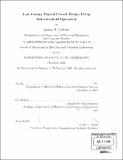Low energy digital circuit design using sub-threshold operation
Author(s)
Calhoun, Benton Highsmith, 1978-
DownloadFull printable version (21.56Mb)
Other Contributors
Massachusetts Institute of Technology. Dept. of Electrical Engineering and Computer Science.
Advisor
Anantha P. Chandrakasan.
Terms of use
Metadata
Show full item recordAbstract
Scaling of process technologies to deep sub-micron dimensions has made power management a significant concern for circuit designers. For emerging low power applications such as distributed micro-sensor networks or medical applications, low energy operation is the primary concern instead of speed, with the eventual goal of harvesting energy from the environment. Sub-threshold operation offers a promising solution for ultra-low-energy applications because it often achieves the minimum energy per operation. While initial explorations into sub-threshold circuits demonstrate its promise, sub-threshold circuit design remains in its infancy. This thesis makes several contributions that make sub-threshold design more accessible to circuit designers. First, a model for energy consumption in sub-threshold provides an analytical solution for the optimum VDD to minimize energy. Fitting this model to a generic circuit allows easy estimation of the impact of processing and environmental parameters on the minimum energy point. Second, analysis of device sizing for sub-threshold circuits shows the trade-offs between sizing for minimum energy and for minimum voltage operation. (cont.) A programmable FIR filter test chip fabricated in 0.18pum bulk CMOS provides measurements to confirm the model and the sizing analysis. Third, a low-overhead method for integrating sub-threshold operation with high performance applications extends dynamic voltage scaling across orders of magnitude of frequency and provides energy scalability down to the minimum energy point. A 90nm bulk CMOS test chip confirms the range of operation for ultra-dynamic voltage scaling. Finally, sub-threshold operation is extended to memories. Analysis of traditional SRAM bitcells and architectures leads to development of a new bitcell for robust sub-threshold SRAM operation. The sub-threshold SRAM is analyzed experimentally in a 65nm bulk CMOS test chip.
Description
Thesis (Ph. D.)--Massachusetts Institute of Technology, Dept. of Electrical Engineering and Computer Science, February 2006. Includes bibliographical references (p. 189-202).
Date issued
2006Department
Massachusetts Institute of Technology. Department of Electrical Engineering and Computer SciencePublisher
Massachusetts Institute of Technology
Keywords
Electrical Engineering and Computer Science.